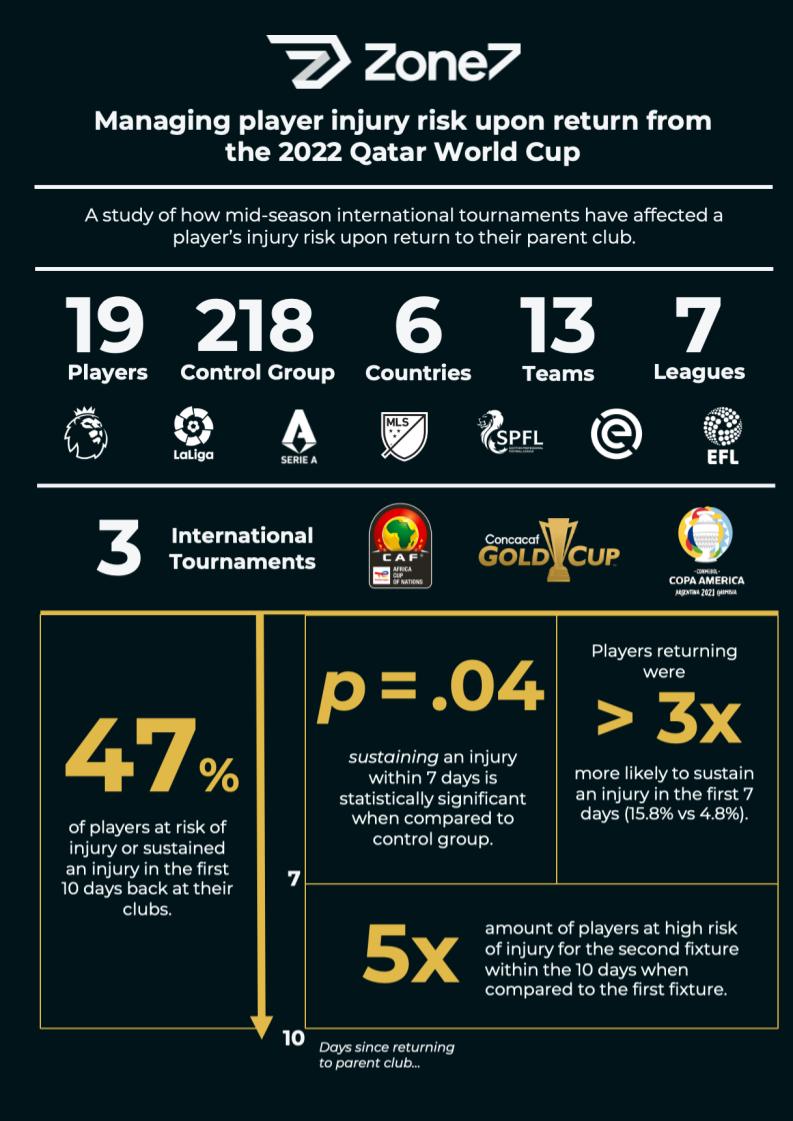With the FIFA World Cup less than a month away the potential injury risk posed by this mid-season tournament on players appears to be attracting significant media attention and commentary.
As a result, Data Research Analyst, Ben Mackenzie has interrogated an appropriate portion of Zone7’s huge football data-lake in order to investigate this further. Specifically, Mackenzie has focused on how mid-season international tournaments such as Afcon 2022, Concacaf Gold Cup 2021, and Copa America 2021, have affected players’ injury risk upon return to their parent clubs.
In this article, Rich Buchanan, Zone7’s Performance Director has offered to provide his personal perspective on the findings, which were shared on social media earlier this month. Buchanan has previously held various positions related to athlete optimization and worked both on the club and international side having worked as Performance Director at Swansea City AFC, Human Performance Consultant for DC United, and as a Consultant Physiotherapist for the Football Association of Wales.

Returning Injury Free
The obvious initial concern for domestic football clubs is that their players return injury free, in condition and ready to compete domestically following completion of the tournament. This desired outcome is fundamentally out of the club’s control, however, fully integrated data sharing for longitudinal monitoring of players could potentially help the clubs to better understand their players’ condition upon return.
Regardless of this, what is controllable for the domestic clubs is how their players are managed upon their return following an international period. The data-derived insights presented in this infographic from Zone7’s research department certainly provide club coaches, performance and medical staff directly affected by the 2022 World Cup with some real objective food for thought.
Difficulties of a Mid-Season Tournament
Unlike the regular international match periods, a mid-season international tournament involves a period of extended time away from their parent club during which time a player’s training and match rhythm is likely to be altered when compared to that of domestic club football. This change in rhythm and potential alteration in the way it is administered could subject the player to stresses that they would not normally be accustomed to. Does this make players more susceptible to injury during or after the tournament?
Maybe. Gabbett (2016) proposed a relationship between the chronic training history of an athlete and their acute training history with respect to injury mitigation that instigated debate amongst performance practitioners as to how subtle changes in workload (Mechanical, locomotive, or cardiovascular) could impact an athlete’s risk of injury. This is something that is particularly pertinent to the environmental changes a mid-season international tournament such as World Cup 2022 presents.
The stand-out result from Zone7’s investigation into injury incidence following past mid-season tournaments was that players returning from such tournaments are more likely to incur an injury during the first seven days back when compared to those players that have remained at the parent club and continued with the normal training and match schedule (15.8% v 4.8%, p = .04). For lots of potential reasons, this statistic begs the question as to whether the reintegration of international players is sufficiently considered and injury risk mitigated relating to the change in training and game rhythm, altered physical demands, emotional factors, climate and time-zone changes. Interestingly for the 2022 World Cup, the players remaining at their domestic clubs are facing similar disruption to their rhythms and that is another complicated consideration to bear in mind for practitioners this winter.
A further interesting insight to consider is that when two games were played within 10 days of players returning, five times the number of those players were deemed at ‘high-risk’ of injury by Zone7’s injury risk forecasting algorithm for the second fixture than the first. Is this due to a change in rhythm, the differing demands of the domestic game or related to recovery periods and processes? Probably a combination of all.
Conclusion
The key take-home message for all the games stakeholders from this Zone7 investigation is:
The reintegration period for international players is critical across the first week to 10 days especially if this is a two-game period.
This timeframe is when domestic club staff can to a certain degree, control the controllables. Armed with the knowledge presented, amplifying collaborative practices across all the departments including the players themselves to mitigate injury risk would seem optimal. Even when a player is indispensable to the team, for this specific reintegration period, a heightened approach to manage workloads and recovery interventions which indeed may need to differ from the normative club routines and protocols would seemingly be very sensible.
When international tournaments like the World Cup 2022 come along many simply hope for the best. Whilst not a lot in life is guaranteed, Zone7’s data-derived insights do provide objective evidence and rationale for considered measures to be taken by the domestic clubs to mitigate injury risk, enhance player well-being and strive for better player availability rates post tournament.
References
Gabbett, T, J. (2016). The training-injury prevention paradox: Should athletes be training smarter and harder? British Journal of Sports Medicine, 50, 273-280.
Ready to Elevate your Performance? We provide a comprehensive suite of products and services utilizing data and AI to enable greater performance and durability amongst high-performance teams.
To find out more about our work, Book a Demo today.


